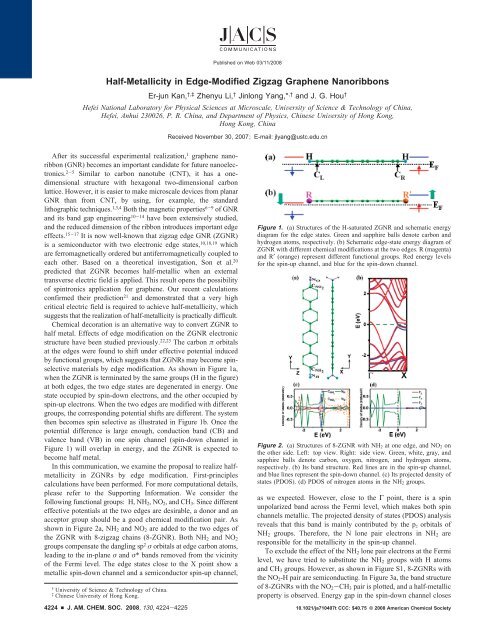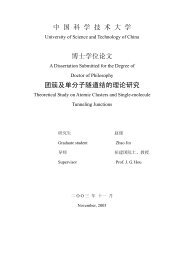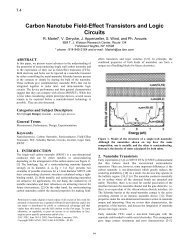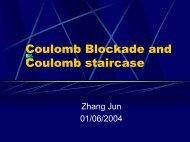Half-Metallicity in Edge-Modified Zigzag Graphene Nanoribbons
Half-Metallicity in Edge-Modified Zigzag Graphene Nanoribbons
Half-Metallicity in Edge-Modified Zigzag Graphene Nanoribbons
Create successful ePaper yourself
Turn your PDF publications into a flip-book with our unique Google optimized e-Paper software.
<strong>Half</strong>-<strong>Metallicity</strong> <strong>in</strong> <strong>Edge</strong>-<strong>Modified</strong> <strong>Zigzag</strong> <strong>Graphene</strong> <strong>Nanoribbons</strong><br />
Er-jun Kan, †,‡ Zhenyu Li, † J<strong>in</strong>long Yang,* ,† and J. G. Hou †<br />
Hefei National Laboratory for Physical Sciences at Microscale, UniVersity of Science & Technology of Ch<strong>in</strong>a,<br />
Hefei, Anhui 230026, P. R. Ch<strong>in</strong>a, and Department of Physics, Ch<strong>in</strong>ese UniVersity of Hong Kong,<br />
Hong Kong, Ch<strong>in</strong>a<br />
After its successful experimental realization, 1 graphene nanoribbon<br />
(GNR) becomes an important candidate for future nanoelectronics.<br />
2-5 Similar to carbon nanotube (CNT), it has a onedimensional<br />
structure with hexagonal two-dimensional carbon<br />
lattice. However, it is easier to make microscale devices from planar<br />
GNR than from CNT, by us<strong>in</strong>g, for example, the standard<br />
lithographic techniques. 1,3,4 Both the magnetic properties 6-9 of GNR<br />
and its band gap eng<strong>in</strong>eer<strong>in</strong>g 10-14 have been extensively studied,<br />
and the reduced dimension of the ribbon <strong>in</strong>troduces important edge<br />
effects. 15-17 It is now well-known that zigzag edge GNR (ZGNR)<br />
is a semiconductor with two electronic edge states, 10,18,19 which<br />
are ferromagnetically ordered but antiferromagnetically coupled to<br />
each other. Based on a theoretical <strong>in</strong>vestigation, Son et al. 20<br />
predicted that ZGNR becomes half-metallic when an external<br />
transverse electric field is applied. This result opens the possibility<br />
of sp<strong>in</strong>tronics application for graphene. Our recent calculations<br />
confirmed their prediction 21 and demonstrated that a very high<br />
critical electric field is required to achieve half-metallicity, which<br />
suggests that the realization of half-metallicity is practically difficult.<br />
Chemical decoration is an alternative way to convert ZGNR to<br />
half metal. Effects of edge modification on the ZGNR electronic<br />
structure have been studied previously. 22,23 The carbon π orbitals<br />
at the edges were found to shift under effective potential <strong>in</strong>duced<br />
by functional groups, which suggests that ZGNRs may become sp<strong>in</strong>selective<br />
materials by edge modification. As shown <strong>in</strong> Figure 1a,<br />
when the ZGNR is term<strong>in</strong>ated by the same groups (H <strong>in</strong> the figure)<br />
at both edges, the two edge states are degenerated <strong>in</strong> energy. One<br />
state occupied by sp<strong>in</strong>-down electrons, and the other occupied by<br />
sp<strong>in</strong>-up electrons. When the two edges are modified with different<br />
groups, the correspond<strong>in</strong>g potential shifts are different. The system<br />
then becomes sp<strong>in</strong> selective as illustrated <strong>in</strong> Figure 1b. Once the<br />
potential difference is large enough, conduction band (CB) and<br />
valence band (VB) <strong>in</strong> one sp<strong>in</strong> channel (sp<strong>in</strong>-down channel <strong>in</strong><br />
Figure 1) will overlap <strong>in</strong> energy, and the ZGNR is expected to<br />
become half metal.<br />
In this communication, we exam<strong>in</strong>e the proposal to realize halfmetallicity<br />
<strong>in</strong> ZGNRs by edge modification. First-pr<strong>in</strong>ciples<br />
calculations have been performed. For more computational details,<br />
please refer to the Support<strong>in</strong>g Information. We consider the<br />
follow<strong>in</strong>g functional groups: H, NH2,NO2, and CH3. S<strong>in</strong>ce different<br />
effective potentials at the two edges are desirable, a donor and an<br />
acceptor group should be a good chemical modification pair. As<br />
shown <strong>in</strong> Figure 2a, NH2 and NO2 are added to the two edges of<br />
the ZGNR with 8-zigzag cha<strong>in</strong>s (8-ZGNR). Both NH2 and NO2<br />
groups compensate the dangl<strong>in</strong>g sp 2 σ orbitals at edge carbon atoms,<br />
lead<strong>in</strong>g to the <strong>in</strong>-plane σ and σ* bands removed from the vic<strong>in</strong>ity<br />
of the Fermi level. The edge states close to the X po<strong>in</strong>t show a<br />
metallic sp<strong>in</strong>-down channel and a semiconductor sp<strong>in</strong>-up channel,<br />
† University of Science & Technology of Ch<strong>in</strong>a.<br />
‡ Ch<strong>in</strong>ese University of Hong Kong.<br />
Published on Web 03/11/2008<br />
Received November 30, 2007; E-mail: jlyang@ustc.edu.cn<br />
Figure 1. (a) Structures of the H-saturated ZGNR and schematic energy<br />
diagram for the edge states. Green and sapphire balls denote carbon and<br />
hydrogen atoms, respectively. (b) Schematic edge-state energy diagram of<br />
ZGNR with different chemical modifications at the two edges. R (magenta)<br />
and R′ (orange) represent different functional groups. Red energy levels<br />
for the sp<strong>in</strong>-up channel, and blue for the sp<strong>in</strong>-down channel.<br />
Figure 2. (a) Structures of 8-ZGNR with NH2 at one edge, and NO2 on<br />
the other side. Left: top view. Right: side view. Green, white, gray, and<br />
sapphire balls denote carbon, oxygen, nitrogen, and hydrogen atoms,<br />
respectively. (b) Its band structure. Red l<strong>in</strong>es are <strong>in</strong> the sp<strong>in</strong>-up channel,<br />
and blue l<strong>in</strong>es represent the sp<strong>in</strong>-down channel. (c) Its projected density of<br />
states (PDOS). (d) PDOS of nitrogen atoms <strong>in</strong> the NH2 groups.<br />
as we expected. However, close to the Γ po<strong>in</strong>t, there is a sp<strong>in</strong><br />
unpolarized band across the Fermi level, which makes both sp<strong>in</strong><br />
channels metallic. The projected density of states (PDOS) analysis<br />
reveals that this band is ma<strong>in</strong>ly contributed by the pz orbitals of<br />
NH2 groups. Therefore, the N lone pair electrons <strong>in</strong> NH2 are<br />
responsible for the metallicity <strong>in</strong> the sp<strong>in</strong>-up channel.<br />
To exclude the effect of the NH2 lone pair electrons at the Fermi<br />
level, we have tried to substitute the NH2 groups with H atoms<br />
and CH3 groups. However, as shown <strong>in</strong> Figure S1, 8-ZGNRs with<br />
the NO2-H pair are semiconduct<strong>in</strong>g. In Figure 3a, the band structure<br />
of 8-ZGNRs with the NO2-CH3 pair is plotted, and a half-metallic<br />
property is observed. Energy gap <strong>in</strong> the sp<strong>in</strong>-down channel closes<br />
4224 9 J. AM. CHEM. SOC. 2008, 130, 4224-4225 10.1021/ja710407t CCC: $40.75 © 2008 American Chemical Society
Figure 3. (a) Band structure and (b) sp<strong>in</strong> density of ZGNRs modified by<br />
the NO2-CH3 pair. Red represents the sp<strong>in</strong>-up channel, and blue represents<br />
the sp<strong>in</strong>-down channel. (c) The band gaps of ZGNR-full (red) and ZGNRhalf<br />
(blue) with sp<strong>in</strong>-up (squre) and sp<strong>in</strong>-down (circle) channels. Please<br />
refer to the text for the def<strong>in</strong>itions of ZGNR-full and ZGNR-half.<br />
around the X po<strong>in</strong>t, just as <strong>in</strong> the NO2-NH2 pair. The sp<strong>in</strong> density<br />
for the ZGNR with the NO2-CH3 pair (Figure 3b) ma<strong>in</strong>ly<br />
distributes on the edge atoms. This is because that, as <strong>in</strong> H<br />
term<strong>in</strong>ation, the NO2 and CH3 groups compensate the dangl<strong>in</strong>g sp 2<br />
σ orbitals at each carbon edge site and have little contribution to<br />
the π orbitals of the edge states. However, the higher electron<br />
density will lift the energy of occupied orbitals. The band gaps of<br />
the ZGNRs are thus reduced, as shown <strong>in</strong> previous results. 22,23<br />
The relative stability of edge-modified ZGNRs is very important<br />
<strong>in</strong> practice. Because these structures have different chemical<br />
compositions, the b<strong>in</strong>d<strong>in</strong>g energy per atom does not provide a<br />
suitable measurement for the comparison of their relative stability.<br />
Therefore, we adopt the approach used <strong>in</strong> tertiary phase thermodynamics<br />
to account for chemical composition and to analyze the<br />
relative stability of functional ZGNRs. 22 We def<strong>in</strong>e a Gibbs free<br />
energy of formation δG for edge-modified ZGNRs as δG )<br />
Ec- nHµH - nOµO- nNµN - nCµC, where Ec is the cohesive energy<br />
per atom of chemically functionalized ZGNRs, and ni is the molar<br />
fraction of atom i (i ) C, O, H, N) <strong>in</strong> the ribbons, satisfy<strong>in</strong>g the<br />
relation nH + nO + nN + nC ) 1. The b<strong>in</strong>d<strong>in</strong>g energy per atom of<br />
H2,N2, and O2 molecules are chosen as µH, µO, and µN, respectively,<br />
and µC is the cohesive energy per atom of the <strong>in</strong>f<strong>in</strong>ite graphene.<br />
ZGNR modified by one NO2-CH3 pair per ZGNR unit (ZGNRfull)<br />
is less stable and has a larger δG than the H-saturated one.<br />
This is easy to understand s<strong>in</strong>ce the nearest-neighbor<strong>in</strong>g NO2 and<br />
CH3 group repulsion is too large at short distances. To obta<strong>in</strong> more<br />
stable products, we construct a new structure, where there is only<br />
one NO2 and CH3 pair every two unit cells (ZGNR-half). Because<br />
the distances between the neighbor<strong>in</strong>g CH3 groups are larger than<br />
4.5 Å now, the calculated Gibbs free energy of formation is greatly<br />
reduced. ZGNR-half is even more stable than H-saturated ZGNR.<br />
As shown <strong>in</strong> Figure 3c, ZGNR-half becomes a sp<strong>in</strong> selective<br />
semiconductor, but we f<strong>in</strong>d that the sp<strong>in</strong>-down gap becomes<br />
narrower when the ribbon width <strong>in</strong>creases. ZGNR-half turns to half<br />
metal when it is wider than 12-zigzag cha<strong>in</strong>s. We also checked the<br />
ribbon width dependence for ZGNR-full. At high NO2 and CH3<br />
concentration, the nanoribbon is always half metal for a width larger<br />
than 8. Therefore, the only difference brought by the term<strong>in</strong>al group<br />
concentration is the critical width to obta<strong>in</strong> half-metallicity, which<br />
is because of the difference of the effective potential shift at the<br />
edges. In our ZGNR-half structure, the NO2-CH3 pair is located<br />
on the same armchair C atom row. We have also tested the condition<br />
where the NO2 and CH3 groups are at different C atom rows and<br />
have found no qualitative difference. We also expect to get half<br />
metals with lower term<strong>in</strong>al group concentrations <strong>in</strong> wider nanoribbons.<br />
It is also <strong>in</strong>terest<strong>in</strong>g to note that different types of sp<strong>in</strong>down<br />
band gap are observed. It is direct for ZGNR-full and <strong>in</strong>direct<br />
for ZGNR-half (Figure S3). Such a difference is expected to be<br />
important for the optical property of ZGNRs.<br />
In summary, we have presented a detailed study on the electronic<br />
properties and relative stabilities of several edge-modified ZGNRs.<br />
Some wide ribbons with NO2 groups at one edge and CH3 groups<br />
at the other edge are half metal. By reduc<strong>in</strong>g the concentration of<br />
big functional groups, the half-metallic ribbons can be more stable<br />
than H-saturated ones. Our results thus provide a practical way to<br />
produce ZGNR based sp<strong>in</strong>tronic devices.<br />
Acknowledgment. This work is partially supported by the<br />
National Natural Science Foundation of Ch<strong>in</strong>a (50721091, 20533030,<br />
50731160010), by the National Key Basic Research Program under<br />
Grant No. 2006CB922004, by the USTC-HP HPC project, and by<br />
the SCCAS and Shanghai Supercomputer Center.<br />
Support<strong>in</strong>g Information Available: Computational details, band<br />
structures of other calculated ZGNR models, and free energy of<br />
formation for ZGNR-full and ZGNR-half with different widths. This<br />
material is available free of charge via the Internet at http://pubs.acs.org.<br />
References<br />
(1) Novoselov, K. S.; Geim, A. K.; Morozov, S. V.; Jiang, D.; Zhang, Y.;<br />
Dubonos, S. V.; Grigorieva, I. V.; Firsov, A. A. Science 2004, 306, 666.<br />
(2) Geim, A. K.; Novoselov, K. S. Nat. Mater. 2007, 6, 183.<br />
(3) Berger, C.; Song, Z.; Li, X.; Wu, X.; Brown, N.; Naud, C.; Mayou, D.;<br />
Li, T.; Hass, J.; Marchenkov, A. N.; Conrad, E. H.; First, P. N.; De Heer,<br />
W. A. Science 2006, 312, 1191.<br />
(4) Zhang, Y.; Tan, Y.; Stormer, H.; Kim, P. Nature 2005, 438, 201.<br />
(5) Novoselov, K. S.; Jiang, Z.; Zhang, Y.; Morozov, S. V.; Stormer, H. L.;<br />
Zeitler, U.; Maan, J. C.; Boeb<strong>in</strong>ger, G. S.; Kim, P.; Geim, A. K. Science<br />
2007, 315, 1379.<br />
(6) Fujita, M.; Wakabayashi, K.; Nakada, K.; Kusakabe, K. J. Phys. Soc.<br />
Jpn. 1996, 65, 1920.<br />
(7) (a)Wakabayashi, K.; Sigrist, M.; Fujita, M. J. Phys. Soc. Jpn. 1998, 67,<br />
2089. (b) Wakabayashi, K.; Fujita, M.; Ajiki, H.; Sigrist, M. Phys. ReV.<br />
B 1999, 59, 8271.<br />
(8) Kusakabe, K.; Maruyama, M. Phys. ReV. B2003, 67, 092406.<br />
(9) Yamashiro, A.; Shimoi, Y.; Harigaya, K.; Wakabayashi, K. Phys. ReV. B<br />
2003, 68, 193410.<br />
(10) Son, Y.-W.; Cohen, M. L.; Louie, S. G. Phys. ReV. Lett. 2006, 97, 216803.<br />
(11) Barone, V.; Hod, O.; Scuseria, G. E. Nano Lett. 2006, 6, 2748.<br />
(12) Ren, H.; Li, Q.; Su, H.; Shi, Q. W.; Chen, J.; Yang, J. L. arXiv: 0711.1700<br />
(http://arxiv.org/abs/0711.1700).<br />
(13) Chen, Z.; L<strong>in</strong>, Y.; Rooks, M. J.; Avouris, P. Physica E (Amsterdam) 2007,<br />
40, 228.<br />
(14) Han, M. Y.; Ozyilmaz, B.; Zhang, Y.; Kim, P. Phys. ReV. Lett. 2007, 98,<br />
206805.<br />
(15) Silvestrov, P. G.; Efetov, K. B. Phys. ReV. Lett. 2007, 98, 016802.<br />
(16) Hod, O.; Barone, V.; Scuseria, G. E. Phys. ReV. B2008, 77, 035411.<br />
(17) Hod, O.; Peralta, J. E.; Scuseria, G. E. Phys. ReV. B2007, 76, 233401.<br />
(18) Pisani, L.; Chan, J. A.; Montanari, B.; Harrison, N. M. Phys. ReV.B2007,<br />
75, 064418.<br />
(19) Rudberg, E.; Salek, P.; Luo, Y. Nano Lett. 2007, 7, 2211.<br />
(20) Son, Y.; Cohen, M. L.; Louie, S. G. Nature 2006, 444, 347.<br />
(21) Kan, E. J.; Li, Z.; Yang, J. L.; Hou, J. G. Appl. Phys. Lett. 2007, 91,<br />
243116.<br />
(22) Hod, O.; Barone, V.; Peralta, J. E.; Scuseria, G. E. Nano Lett. 2007, 7,<br />
2295.<br />
(23) Gunlycke, D.; Li, J.; M<strong>in</strong>tmire, J. W.; White, C. T. Appl. Phys. Lett. 2007,<br />
91, 112108.<br />
JA710407T<br />
COMMUNICATIONS<br />
J. AM. CHEM. SOC. 9 VOL. 130, NO. 13, 2008 4225






